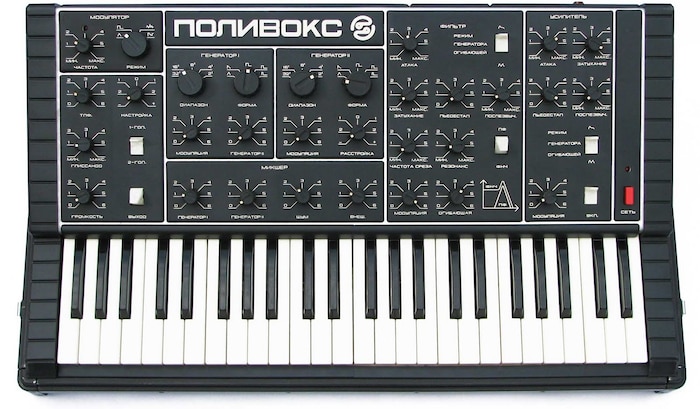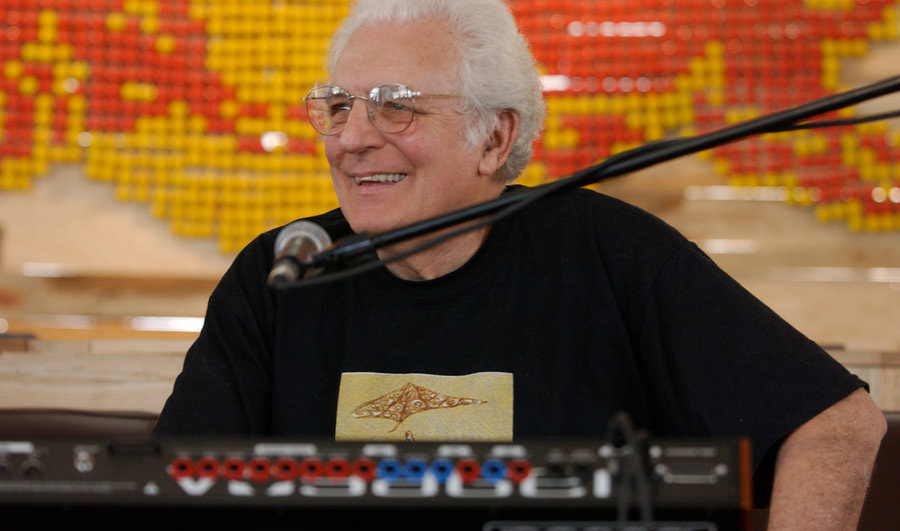Interview: Vladimir Kuzmin, Engineer Behind the Polivoks Synthesizer
Developed at the tail-end of the Cold War, the Polivoks synthesizer embodied life in communist Russia: with a raw military design, harsh noises and Cyrillic lettering, the duophonic, analog machine stood apart in appearance and sound.

The Polivoks was the brainchild of Ekaterinburg-based circuit designer Vladimir Kuzmin and his wife Olimpiada, who crafted the instrument’s sleek, tank-like image. Only 25,000 or so units reached the Soviet market before production ceased in 1990. Prior to 1991, when the Iron Curtain collapsed, the Western world was largely unaware of Soviet novelties – a guarded and isolated economy ensured that products remained within Russian borders. Once these opened up, word of the Polivoks spread to neighboring countries like Germany and Poland, and they became an important backbone of hard techno and industrial music. More recently, you can hear it used on Franz Ferdinand’s 2009 album Tonight: Franz Ferdinand, as well as Goldfrapp’s Black Cherry.
In this interview with Vladimir, Ashley Zlatopolsky dives into the birth of the Polivoks and its transformation from a secret Soviet instrument to a staple of modern synthesizer culture.
Where were you born?
I was born in Vladivostok in 1953 and I was the second child in our family. I was born in October. A month earlier, in September, [Soviet Union leader Joseph] Stalin died.
Can you tell me a bit about your family life?
My father was a military man and our family traveled through the country. We stopped traveling when my father stopped serving in the Soviet Army – he was a communist, but he never shot anyone. After some time and some family problems, our family moved to Sverdlovsk, now Ekaterinburg.
You were in a student band early on.
Yes. All four band members were friends from one grade. In this band I made my first bass guitar. There was no industry to make [electric] guitars in shops. After grade school I entered mining college and graduated in 1976 with a degree in electronics. All throughout college I played in the band and made two more basses, amps and electronic effects for bass and electric guitar. We played modern Soviet music, The Beatles, some other foreign music and our own songs. (The men in our band were good composers and songwriters, including me.)
In the Soviet Union, the music industry was very strange and very old.
Why was there no guitar industry? Where would people get guitars?
For ordinary people, there was nowhere to go, really, so we had to make them ourselves. We made electric guitars from regular acoustic guitars by inserting magnet pickups; this way we could get an electric sound. Things like electric guitars and synthesizers simply weren’t in Soviet culture back then – those sounds hadn’t reached us yet. We only had folk instruments, pianos, accordions, very traditional items. In the Soviet Union, the music industry was very strange and very old. Since the economy suffered very much during World War II, most of the manufacturing facilities were restricted to agriculture, mining, rare materials and construction; music was not the first goal.
Did the Soviet government control the music industry?
The U.S.S.R. had planned economics, i.e. each product was planned then manufactured in the planned quantity. There were no forecasts as to what musical products would be needed in the future.
I’ve read that the Soviet Ministry of Culture did not allow import of foreign instruments. How were you able to see Western (and also Japanese) gear and synthesizers? Did any enter Russia illegally?
There was no illegal market at all in the U.S.S.R., but we still had an opportunity to see Western or Japanese gear through [touring] bands and ensembles. Plus restaurant bands and musicians had an opportunity – and cash – to buy equipment from Polish, Czech and German musicians who visited the U.S.S.R on tour. It was profitable for them not to carry heavy gear back home but to [instead] sell it here and buy something else; for example, photo cameras were very cheap here.
So a market existed for touring bands to sell gear in Russia?
These ensembles from Poland, Romania, Hungary, Germany, Czechoslovakia – they were a lot closer to the West than us and they knew they had an opportunity here. We had dealers here who circled around these ensembles and offered them – in rubles, of course – Soviet items to bring back home. Aside from cameras, watches were very cheap. These dealers would buy synthesizers, electric guitars, organs... they would sell for big money here. We didn’t get many American instruments, though.
Was the Polivoks always a dream for you?
I wanted to invent something close to Peter Zinovieff’s Synthi 100; I dreamed to manufacture something like this.
The ATTACK knob was supposed to give it a feeling of a military synthesizer.
How did the idea of the Polivoks develop from that?
As it was planned economics, Vector [the factory where I worked] also had its plan regarding what to manufacture. It was a war factory, and they decided one day to change and produce electronic instruments. The plans were five-year plans, so we planned what to manufacture year by year – there were plans to manufacture electronic organs, amps, cabinets and later synthesizers [like the Polivoks], piano strings, digital keyboards and effects processors. On my own, I planned other projects like digital keyboards and vocoders.
What were some of the most important features you wanted to include? What made the Polivoks different from other synthesizers?
I wanted to give musicians the opportunity to have the sounds of well-known synths like Moog, KORG and Roland. To me, the only thing that made the Polivoks different from other synthesizers is that is has no joystick, and all control parameters have wider limits with maximum variants of control.
In your eyes, what kind of product did you see in front of you?
It was a Russian military brutal synthesizer. Brutal male sounds. You need to hear it obviously, but it looks like a tank with custom knobs.
Your wife Olimpiada developed the design. Why did she choose this military style?
Olimpiada has a diploma in design – she graduated from an architectural academy in Sverdlovsk (now Ekaterinberg), so she tried out various styles on Vector’s products. She made some design sketches and we came to the conclusion that having a military design would be very innovative for synthesizers; a synthesizer was never made in this style before or even after. Its 3D control panel design depicts its module structure, and our color scheme was khaki to underline the military aesthetic. The ATTACK knob on the Polivoks was supposed to give it a feeling of a military synthesizer.
Every musician who uses the Polivoks finds something for their music... In some cases, I myself don’t understand how they achieve certain sounds.
Where could people buy a Polivoks? I’ve read that they sold for 920 rubles.
920 rubles is a very high figure but not so high for cultural organizations. Vector couldn't sell its products directly to customers, only to shops according to the previously signed contracts. It was often too expensive for individuals.
During its years on the market from 1982-1990, did the Polivoks evolve in technology, appearance or sound?
Common sound or schematics weren’t changed, but some changes were made to improve stability, simplification of testing and tuning modules. Also, new materials were implemented for printed circuit boards with less leakage.
Production eventually stopped. What happened?
All production depends on the number of contracts, and it seems that the number simply became less. I don’t know the real reason production stopped because I left Vector in 1991 – in that year, the U.S.S.R fell down, all republics became separate states and the state net of shops also fell down.
Why did you leave Vector? Where did you go?
There was no money left to manufacture, no money for production. The factory simply stopped working, so I had to find other work. My entire engineering bureau – eight people – left the factory together. We were all very good engineers and organized our own separate bureau and worked on projects for other factories.
Before the Iron Curtain fell, was the Polivoks solely a U.S.S.R. product?
Yes, it was solely a U.S.S.R. product – we manufactured 25,000 Polivoks. It was never manufactured in other countries and also never sold to other countries. But in 1991 all borders were opened and many people started trying to access our products to sell to foreign countries. This was a small business but we must thank these people [because it spread the word of the Polivoks].
Did you know back then that people were collecting the Polivoks worldwide?
I didn’t track its life at all from 1991 to the early ‘00s until I began to use the internet. It was a big surprise for me and Olimpiada. We are very happy that we did something significant in our lives.
Artists like Franz Ferdinand and Goldfrapp have used the Polivoks. Is it strange for you to see the product used in so many types of music?
It’s amazing: there are so many styles of music and [the use of the Polivoks] sounds different in each kind. Every musician who uses the Polivoks finds something for their music, from hard techno to dark music to cosmic space. In some cases, I myself don’t understand how they achieve certain sounds.
How much does a Polivoks sell for nowadays?
eBay price for the Polivoks ranges from $800 to $1,500 depending on its condition. Polivoks has bullet-proof reliability and very simple construction – its module structure allows for simple repairs. I think that each Polivoks manufactured by Vector is still alive.
You no longer produce the Polivoks, but [Seattle-based synthesizer company] The Harvestman makes their own version. How did that happen?
I have a friend in America, Shawn Cleary [of Analogue Haven] and we talk often. He has his own synthesizer shop and he introduced me to the director of Harvestman. It’s a great company with great people and their products have personality.
Would you ever consider bringing the Polivoks back yourself, though?
Russian proverb says: it’s not possible to step in the same water twice.

